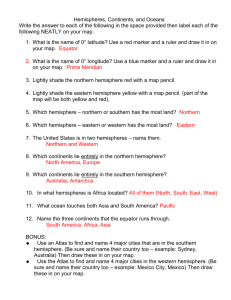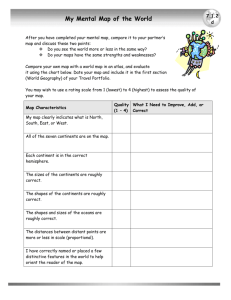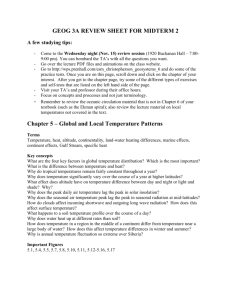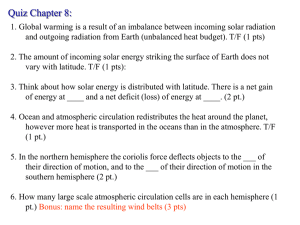Master Syllabus Course: BIO 112, The Ocean Environment
advertisement
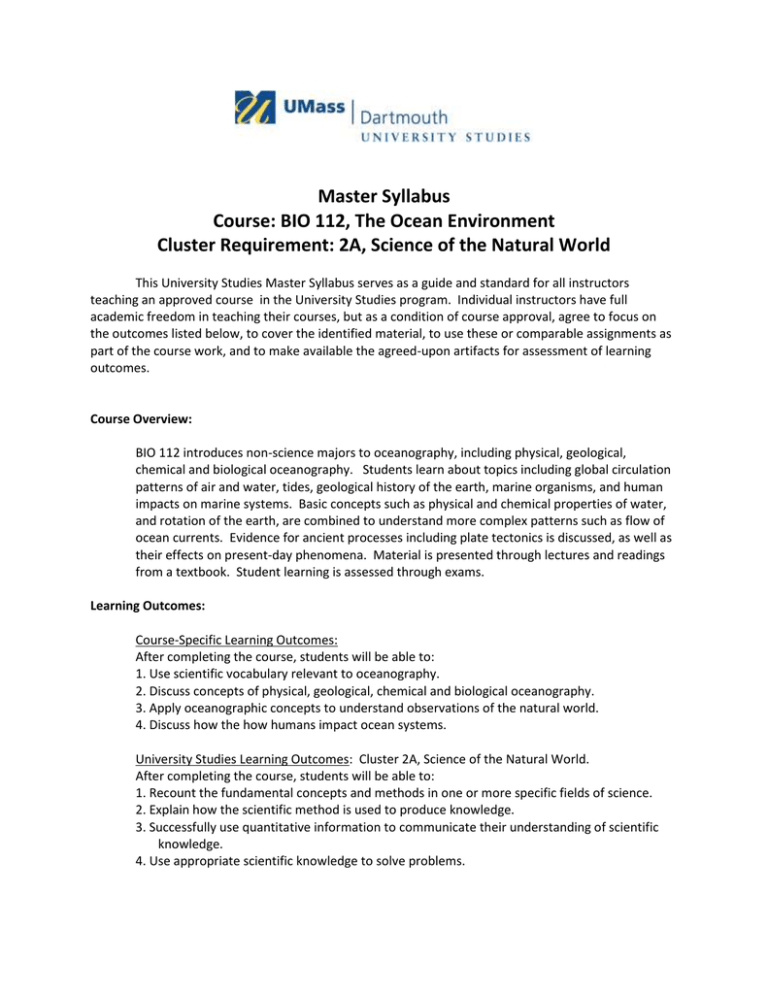
Master Syllabus Course: BIO 112, The Ocean Environment Cluster Requirement: 2A, Science of the Natural World This University Studies Master Syllabus serves as a guide and standard for all instructors teaching an approved course in the University Studies program. Individual instructors have full academic freedom in teaching their courses, but as a condition of course approval, agree to focus on the outcomes listed below, to cover the identified material, to use these or comparable assignments as part of the course work, and to make available the agreed-upon artifacts for assessment of learning outcomes. Course Overview: BIO 112 introduces non-science majors to oceanography, including physical, geological, chemical and biological oceanography. Students learn about topics including global circulation patterns of air and water, tides, geological history of the earth, marine organisms, and human impacts on marine systems. Basic concepts such as physical and chemical properties of water, and rotation of the earth, are combined to understand more complex patterns such as flow of ocean currents. Evidence for ancient processes including plate tectonics is discussed, as well as their effects on present-day phenomena. Material is presented through lectures and readings from a textbook. Student learning is assessed through exams. Learning Outcomes: Course-Specific Learning Outcomes: After completing the course, students will be able to: 1. Use scientific vocabulary relevant to oceanography. 2. Discuss concepts of physical, geological, chemical and biological oceanography. 3. Apply oceanographic concepts to understand observations of the natural world. 4. Discuss how the how humans impact ocean systems. University Studies Learning Outcomes: Cluster 2A, Science of the Natural World. After completing the course, students will be able to: 1. Recount the fundamental concepts and methods in one or more specific fields of science. 2. Explain how the scientific method is used to produce knowledge. 3. Successfully use quantitative information to communicate their understanding of scientific knowledge. 4. Use appropriate scientific knowledge to solve problems. Examples of Texts and/or Assigned Readings: Essentials of Oceanography, 10th Edition (2011) by Trujillo & Thurman Example Assignments: Three exams will be used to assess the Cluster 2A learning outcomes. Examples of exam questions: Outcome 1. Recount the fundamental concepts and methods in one or more specific fields of science. Answer (A) – high pressure or (B) – low pressure. 1. zone of storm development 2. air pressure over northern hemisphere gyres in summer 3. air pressure over northern hemisphere continents in summer 4. air pressure over northern hemisphere continents in winter 5. hurricane zones 6. causes cool, clear weather 7. air pressure at 60⁰ N in Atlantic & Pacific in winter 8. air pressure at 60⁰ S year-round 9. when it is east of New England we have a “noreaster” 10. air pressure at the Equator year-round Outcome 2. Explain how the scientific method is used to produce knowledge. 1. Give 5 types of evidence presented by Wegener for continental drift. Select answers from the list below. 2. Give 5 types of evidence for plate tectonics discovered in the decades since Wegener’s death. Select answers from the list below. A. B. C. D. E. F. G. H. I. J. K. L. fit of continental outlines formation of oceanic islands over hot spots existence of global mid-ocean ridge, oceanic trench, terrestrial fault system fossils of animals on now separate continents that could not have crossed oceans young oceanic crust (less than 180-200 million years old) continuous mountain ranges on separated continents continuous deposits of coal on separated continents evidence of glaciers in areas now in the tropics symmetric paleomagnetic reversals on either side of the mid-ocean ridge global distribution pattern of earthquakes increasing age moving northward in the Great Barrier Reef global distribution pattern of geothermal heat flow Outcome 3. Successfully use quantitative information to communicate their understanding of scientific knowledge. Answer questions 1-10 with one of letters A-J 1. Many present-day continents barely recognizable 2. Pangaea separated and continents moved to present positions 3. Time of Southern Hemisphere glaciation 4. Time of Northern Hemisphere glaciation 5. Continents began to come together to form Pangaea 6. Age of oldest oceanic crust 7. India joined Asia 8. Central American Isthmus formed 9. Age of the Earth 10. Time when the Great Barrier Reef began to form Ma = million years ago A. B. C. D. E. F. G. H. I. J. 540 Ma 540-300 Ma 300 Ma 180 Ma to present 3 – 5 Ma about 180 – 200 million years 45 Ma within the last 2 million years 4.6 billion years 30 Ma Place in numerical order the following events, from 1 for the oldest, through 6 for the most recent. 1. 2. 3. 4. 5. 6. Origin of life Oxygenation of the atmosphere Origin of the Earth Formation of the atmosphere Formation of the ocean Cambrian “explosion” of fossils Outcome 4. Use appropriate scientific knowledge to solve problems. (These questions require students to put together several concepts class to figure out direction of rotation) Answer (A) – clockwise or (B) – counterclockwise. 1. The North Atlantic gyre rotates ____. 2. In the northern hemisphere, Coriolis force makes air masses rotate ____. 3. Circulation around a low pressure zone in the northern hemisphere is ____. 4. The South Atlantic gyre rotates ____. 5. In the southern hemisphere, Coriolis force makes air masses rotate ____. 6. Circulation around a low pressure zone in the southern hemisphere is ____. 7. Circulation around a high pressure zone in the northern hemisphere is ____. 8. Circulation around a high pressure zone in the southern hemisphere is ____. 9. The South Pacific gyre rotates ____. 10. The North Pacific gyre rotates ____. Sample Course Outline: (Chapters in the text accompanying topics are noted) Introduction to Planet Earth (Chapter 1) Air-Sea Interaction (Chapter 6) Ocean Circulation (Chapter 7) Waves and Water Dynamics (Chapter 8) Tides (Chapter 9) TEST #1 Plate Tectonics and the Ocean Floor (Chapter 2) Marine Sediments (Chapter 4) History of the Earth and Life, Glaciation, & Extinctions (no specific chapter in the text covers this) TEST #2 Water and Seawater (Chapter 5) Nutrients, Sewage and Eutrophication (no specific chapter in the text covers this) The Basis of Biological Classification and Diversity (no specific chapter in the text covers this) Marine Life and the Marine Environment (Chapter 12) Biological Productivity and Energy Transfer (Chapter 13) Animals of the Pelagic Environment – Plankton and Nekton (Chapter 14) Animals of the Benthic Environment (Chapter 15) The Oceans and Climate Change (Chapter 16) Pollution and Other Environmental Issues in the Sea/The Coastal Ocean (Chapter 11 and p. 326342) TEST #3


